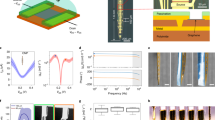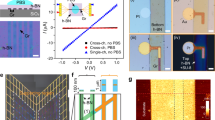Abstract
Recording infraslow brain signals (<0.1 Hz) with microelectrodes is severely hampered by current microelectrode materials, primarily due to limitations resulting from voltage drift and high electrode impedance. Hence, most recording systems include high-pass filters that solve saturation issues but come hand in hand with loss of physiological and pathological information. In this work, we use flexible epicortical and intracortical arrays of graphene solution-gated field-effect transistors (gSGFETs) to map cortical spreading depression in rats and demonstrate that gSGFETs are able to record, with high fidelity, infraslow signals together with signals in the typical local field potential bandwidth. The wide recording bandwidth results from the direct field-effect coupling of the active transistor, in contrast to standard passive electrodes, as well as from the electrochemical inertness of graphene. Taking advantage of such functionality, we envision broad applications of gSGFET technology for monitoring infraslow brain activity both in research and in the clinic.
This is a preview of subscription content, access via your institution
Access options
Access Nature and 54 other Nature Portfolio journals
Get Nature+, our best-value online-access subscription
$29.99 / 30 days
cancel any time
Subscribe to this journal
Receive 12 print issues and online access
$259.00 per year
only $21.58 per issue
Buy this article
- Purchase on Springer Link
- Instant access to full article PDF
Prices may be subject to local taxes which are calculated during checkout






Similar content being viewed by others
Data availability
The experimental data that support the figures within this paper and other findings of this study can be accessed by contacting the corresponding authors. Authors can make data available on request, agreeing on data formats needed.
References
Hughes, S. W., Lőrincz, M. L., Parri, H. R. & Crunelli, V. in Progress in Brain Research Vol. 193 (eds Van Someren, E. J. W., Van Der Werf Y. D., Roelfsema P. R., Mansvelder H. D. & Lopes Da Silva, F. H.) 145-162 (Elsevier, Amsterdam, 2011).
Mitra, A. et al. Spontaneous infra-slow brain activity has unique spatiotemporal dynamics and laminar structure. Neuron 98, 297–305 (2018).
Lecci, S. et al. Coordinated infraslow neural and cardiac oscillations mark fragility and offline periods in mammalian sleep. Sci. Adv. 3, e1602026 (2017).
Mitra, A., Snyder, A. Z., Tagliazucchi, E., Laufs, H. & Raichle, M. E. Propagated infra-slow intrinsic brain activity reorganizes across wake and slow wave sleep. Elife 4, e10781 (2015).
Hiltunen, T. et al. Infra-slow EEG fluctuations are correlated with resting-state network dynamics in fMRI. J. Neurosci. 34, 356–362 (2014).
Leopold, D. A., Murayama, Y. & Logothetis, N. K. Very slow activity fluctuations in monkey visual cortex: implications for functional brain imaging. Cereb. Cortex 13, 422–433 (2003).
Kelly, A. C., Uddin, L. Q., Biswal, B. B., Castellanos, F. X. & Milham, M. P. Competition between functional brain networks mediates behavioral variability. NeuroImage 39, 527–537 (2008).
Chung, D. Y. & Ayata, C. in Primer on Cerebrovascular Diseases 2nd edn (eds Caplan, L. R. et al.) 149-153 (Academic, London, 2017).
Hartings, J. A. et al. The continuum of spreading depolarizations in acute cortical lesion development: examining Leão’s legacy. J. Cereb. Blood Flow Metab. 37, 1571–1594 (2017).
Dreier, J. P. The role of spreading depression, spreading depolarization and spreading ischemia in neurological disease. Nat. Med. 17, 439–447 (2011).
Dreier, J. P. & Reiffurth, C. The stroke–migraine depolarization continuum. Neuron 86, 902–922 (2015).
Lauritzen, M. et al. Clinical relevance of cortical spreading depression in neurological disorders: migraine, malignant stroke, subarachnoid and intracranial hemorrhage, and traumatic brain injury. J. Cereb. Blood Flow Metab. 31, 17–35 (2011).
Hartings, J. A. et al. Direct current electrocorticography for clinical neuromonitoring of spreading depolarizations. J. Cereb. Blood Flow Metab. 37, 1857–1870 (2017).
Dreier, J. P. et al. Recording, analysis, and interpretation of spreading depolarizations in neurointensive care: review and recommendations of the COSBID research group. J. Cereb. Blood Flow Metab. 37, 1595–1625 (2016).
Kovac, S., Speckmann, E.-J. & Gorji, A. Uncensored EEG: The role of DC potentials in neurobiology of the brain. Prog. Neurobiol. 165–167, 51–65 (2018).
Vanhatalo, S., Voipio, J. & Kaila, K. Full-band EEG (FbEEG): an emerging standard in electroencephalography. Clin. Neurophysiol. 116, 1–8 (2005).
Vanhatalo, S. et al. Infraslow oscillations modulate excitability and interictal epileptic activity in the human cortex during sleep. Proc. Natl Acad. Sci. USA 101, 5053–5057 (2004).
Hofmeijer, J. et al. Detecting cortical spreading depolarization with full band scalp electroencephalography:an illusion? Front. Neurol. https://doi.org/10.3389/fneur.2018.00017 (2018).
Ayata, C. & Lauritzen, M. Spreading depression, spreading depolarizations, and the cerebral vasculature. Physiol. Rev. 95, 953–993 (2015).
Stensaas, S. S. & Stensaas, L. J. Histopathological evaluation of materials implanted in the cerebral cortex. Acta Neuropathol. 41, 145–155 (1978).
Li, C. et al. Evaluation of microelectrode materials for direct-current electrocorticography. J. Neural Eng. 13, 016008 (2015).
Nelson, M. J., Pouget, P., Nilsen, E. A., Patten, C. D. & Schall, J. D. Review of signal distortion through metal microelectrode recording circuits and filters. J. Neurosci. Methods 169, 141–157 (2008).
Stacey, W. C. et al. Potential for unreliable interpretation of EEG recorded with microelectrodes. Epilepsia 54, 1391–1401 (2013).
Kuzum, D. et al. Transparent and flexible low noise graphene electrodes for simultaneous electrophysiology and neuroimaging. Nat. Commun. 5, 5259 (2014).
Deneux, T. et al. Accurate spike estimation from noisy calcium signals for ultrafast three-dimensional imaging of large neuronal populations in vivo. Nat. Commun. 7, 12190 (2016).
Fang, H. et al. Capacitively coupled arrays of multiplexed flexible silicon transistors for long-term cardiac electrophysiology. Nat. Biomed. Eng. 1, 0038 (2017).
Heremans, P. et al. Mechanical and electronic properties of thin‐film transistors on plastic, and their integration in flexible electronic applications. Adv. Mater. 28, 4266–4282 (2016).
Hess, L. H., Seifert, M. & Garrido, J. A. Graphene transistors for bioelectronics. Proc. IEEE 101, 1780–1792 (2013).
Kim, B. J. et al. High-performance flexible graphene field effect transistors with ion gel gate dielectrics. Nano Lett. 10, 3464–3466 (2010).
Kostarelos, K., Vincent, M., Hebert, C. & Garrido, J. A. Graphene in the design and engineering of next-generation neural interfaces. Adv. Mater. 29, 1700909 (2017).
Benno, M. B. et al. Mapping brain activity with flexible graphene micro-transistors. 2D Mater. 4, 025040 (2017).
Hébert, C. et al. Flexible graphene solution‐gated field‐effect transistors: efficient transducers for micro‐electrocorticography. Adv. Funct. Mater. 28, 1703976 (2018).
Shinwari, M. W. et al. Microfabricated reference electrodes and their biosensing applications. Sensors 10, 1679 (2010).
Chen, S., Liu, Y. & Chen, J. Heterogeneous electron transfer at nanoscopic electrodes: importance of electronic structures and electric double layers. Chem. Soc. Rev. 43, 5372–5386 (2014).
Brownson, D. A. & Banks, C. E. The electrochemistry of CVD graphene: progress and prospects. Phys. Chem. Chem. Phys. 14, 8264–8281 (2012).
Brownson, D. A. C., Munro, L. J., Kampouris, D. K. & Banks, C. E. Electrochemistry of graphene: not such a beneficial electrode material? RSC Adv. 1, 978 (2011).
Valdes, C. P. et al. Speckle contrast optical spectroscopy, a non-invasive, diffuse optical method for measuring microvascular blood flow in tissue. Biomed. Opt. Express 5, 2769–2784 (2014).
Boas, D. A. & Dunn, A. K. Laser speckle contrast imaging in biomedical optics. J. Biomed. Opt. 15, 011109 (2010).
Shibata, M. & Suzuki, N. Exploring the role of microglia in cortical spreading depression in neurological disease. J. Cereb. Blood Flow Metab. 37, 1182–1191 (2017).
Mitra, A. & Raichle, M. E. How networks communicate: propagation patterns in spontaneous brain activity. Phil. Trans. R. Soc. B 371, 20150546 (2016).
Herreras, O. Local field potentials: myths and misunderstandings. Front. Neural Circuits 10, 101 (2016).
Massimini, M., Huber, R., Ferrarelli, F., Hill, S. & Tononi, G. The sleep slow oscillation as a traveling wave. J. Neurosci. 24, 6862–6870 (2004).
Capone, C. et al. Slow waves in cortical slices: how spontaneous activity is shaped by laminar structure.Cereb. Cortex https://doi.org/10.1093/cercor/bhx326 (2017).
Park, D.-W. et al. Graphene-based carbon-layered electrode array technology for neural imaging and optogenetic applications. Nat. Commun. 5, 5258 (2014).
Carlson, A. P. et al. Cortical spreading depression occurs during elective neurosurgical procedures. J. Neurosurg. 126, 266–273 (2017).
de la Rosa, C. J. L. et al. Frame assisted H2O electrolysis induced H2 bubbling transfer of large area graphene grown by chemical vapor deposition on Cu. Appl. Phys. Lett. 102, 022101 (2013).
Illa, X., Rebollo, B., Gabriel, G., Sánchez-Vives, M. V. & Villa, R. Proc. SPIE 9518, 951803 (2015).
Bandyopadhyay, R., Gittings, A., Suh, S., Dixon, P. & Durian, D. J. Speckle-visibility spectroscopy: a tool to study time-varying dynamics. Rev. Sci. Instrum. 76, 093110 (2005).
Acknowledgements
This work was funded by the European Union’s Horizon 2020 research and innovation programme under grant agreement no. 696656 (Graphene Flagship) and no. 732032 (BrainCom). This work has made use of the Spanish ICTS Network MICRONANOFABS partially supported by MINECO and the ICTS ‘NANBIOSIS’, more specifically by the Micro-NanoTechnology Unit of the CIBER in Bioengineering, Biomaterials and Nanomedicine (CIBER-BBN) at the IMB-CNM. E.M.C. acknowledges that this work has been done in the framework of the PhD in Electrical and Telecommunication Engineering at the Universitat Autònoma de Barcelona. E..C. thanks the Spanish Ministerio de Economía y Competitividad for the Juan de la Cierva postdoctoral grant IJCI-2015–25201. T. Durduran acknowledges support from Fundació CELLEX Barcelona, Ministerio de Economía y Competitividad /FEDER (PHOTODEMENTIA, DPI2015–64358-C2–1-R), the “Severo Ochoa” Programme for Centres of Excellence in R&D (SEV-2015–0522) and the Obra Social “la Caixa” Foundation (LlumMedBcn). M.V.S.V. acknowledges support from MINECO BFU2017-85048-R. ICN2 is supported by the Severo Ochoa programme fromSpanish MINECO (grant no. SEV-2017-0706).
Author information
Authors and Affiliations
Contributions
E.M.C. carried out most of the fabrication and characterization of the gSGFET arrays, contributed to the design and performance of the in vivo experiments, analysed the data and wrote the manuscript. X.I. designed the neural probes and fabricated the microelectrode arrays. A.B.C. contributed to the fabrication and characterization of the gSGFET arrays. M.D. performed the in vivo experiments. P.G., C.H., J.B. and E.P.A. contributed to the growth of the CVD graphene. E.P.A., E.D.C. and J.M.D.L.C. contributed to the transfer of graphene. E.P.A., E.D.C. and G.R. contributed to the characterization of CVD graphene. J.M.A. contributed to the fabrication of the custom electronic instrumentation and development of a Python-based user interface. A.C. contributed to the CSD propagation analysis. R.G.C. contributed in the noise characterization and analysis of the devices. T. Dragojević, E.E.V.R. and T. Durduran contributed to the in vivo measurements and analysis of cerebral blood flow. M.D., M.V.S.V., A.G.B., R.V. and J.A.G. participated in the design of the in vivo experiments and thoroughly reviewed the manuscript. A.G.B. contributed in the design and fabrication of the custom electronic instrumentation, development of a custom gSGFET Python library and analysis of the data. All authors read and reviewed the manuscript.
Corresponding authors
Ethics declarations
Competing interests
Patent application (no. P201831068) filled by CSIC, ICREA, CIBER, ICN2 and IDIBAPS; inventors: A.G.B., E.M.C., X.I., R.V., M.V.S.V. and J.A.G.; concerning a graphene transistor system for measuring electrophysiological signals (pending).
Additional information
Publisher’s note: Springer Nature remains neutral with regard to jurisdictional claims in published maps and institutional affiliations.
Supplementary information
Supplementary Information
Supplementary Table 1, Supplementary Figures 1–13, Supplementary References 1–11
Rights and permissions
About this article
Cite this article
Masvidal-Codina, E., Illa, X., Dasilva, M. et al. High-resolution mapping of infraslow cortical brain activity enabled by graphene microtransistors. Nature Mater 18, 280–288 (2019). https://doi.org/10.1038/s41563-018-0249-4
Received:
Accepted:
Published:
Issue Date:
DOI: https://doi.org/10.1038/s41563-018-0249-4
This article is cited by
-
Clinical translation of graphene-based medical technology
Nature Reviews Electrical Engineering (2024)
-
High-density transparent graphene arrays for predicting cellular calcium activity at depth from surface potential recordings
Nature Nanotechnology (2024)
-
Nanoporous graphene-based thin-film microelectrodes for in vivo high-resolution neural recording and stimulation
Nature Nanotechnology (2024)
-
Hybrid graphene electrode for the diagnosis and treatment of epilepsy in free-moving animal models
NPG Asia Materials (2023)



